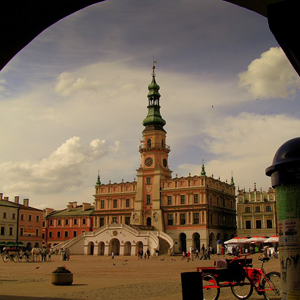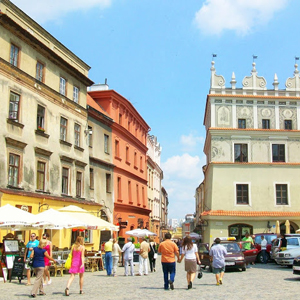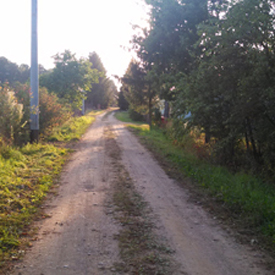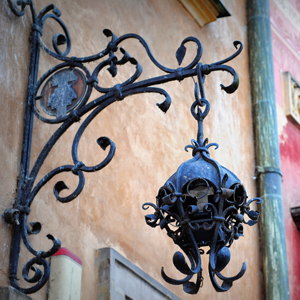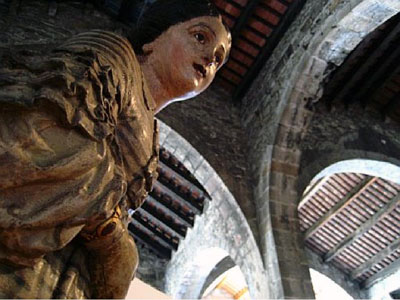
A Victorian masthead at the MUSEU MARÍTIM
Photo by Kayetan Adamski
Barcelona is a city that begs to be enjoyed – visually, intellectually, and culinarily.
It is also a city of endless and varying details: the curve of a Gaudi railing; a centuries-old wooden shutter in the Gothic Quarter; a crystallized cherry blossom on a fragrant pastry; a stone gargoyle smiling at the spires of the neighboring Cathedral.
Such details may very well be missed by a first-time – or even returning – traveler, given the vast scope of experiences, sights – and tasting opportunities in this venerable, yet thoroughly modern, city.
Below is a guide to such select details. Organized by barrio – the Barcelonan neighborhoods that are as distinct from one another as the two façades of the Sagrada Familia – this guide will tune your senses to provide a rich and unique experience of the city.
Benvinguts a Barcelona!
LLOCS (Locations)
MERCAT DE LA BOQUERIA – La Rambla
The many aisles of Barcelona’s central marketplace are perfect for a mid-morning stroll. Seafood, the Catalan specialty pernil ibèric (cured ham), fruit, spices, sweets, treats-all blend together into a lively and bustling swirl.
PALAU DE LA VIRREINA – La Rambla
This quiet, Neo-Classical palau (palace), lovely in and of itself, holds photography exhibitions that change with the seasons. For an additional visual treat, look to your right as you enter the palau off the bustling Ramblas for a large glass case with the richly-costumed figures of gegants (giants), which “march” in Catalan parades.
BARCELONA CATHEDRAL – Barri Gòtic (Gothic Quarter)
After exploring the intricate chapels and altars, take the lift to the rooftop to see all of Barcelona beneath you, and if the air is good – the mountains and sea. The tranquil, fourteenth-century Cloister, located in back of the Cathedral, boasts palm trees, a picturesque fountain, and lovely views of the Cathedral’s spires.
ESGLÉSIA DE SANTA MARIA DEL MAR – Barri Gòtic
This stunning, fourteenth-century church is dedicated to the patron saint of sailors – Saint Mary of the Sea. Its stark, Catalan Gothic simplicity, especially compared with the elaborate Barcelona Cathedral, is beautiful.
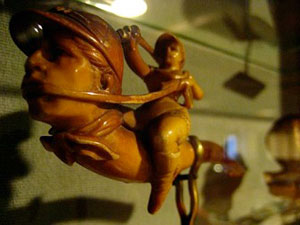
A Victorian pipe at the MUSEU FREDERIC MARÈS
Photo by Kayetan Adamski
MUSEU FREDERIC MARÈS – Barri Gòtic
An absolute must-see, this museum houses the extensive and eclectic collection of Frederic Marès, a wealthy Catalan collector / sculptor. Start with the top floor and work your way down amidst an astounding and at times bizarre array of objets d’art, sculptures, and curios. After admiring the delicate fans, brooches, and other accoutrements of Romantic femininity in the Ladies’ Quarter, peek outside for wonderful views of the Barcelona Cathedral.
MUSEU PICASSO – Barri Gòtic
Located in an exquisite Gothic palau, this museum holds works from Picasso’s formative years, such as Hombre con boina, painted when he was 13, and his Las Meninas Series, based on Velazquez’s work so titled. The exhibitions are arranged chronologically; it’s fascinating to see Picasso’s sketches and ideas, many reflected in later works.
MUSEU MARÍTIM – El Raval
Housed in the original thirteenth-century Royal Ship Yards, the museum features a full-scale replica of the sixteenth-century galley Royal, mastheads, models, and meticulously-researched exhibits that wonderfully convey the magnificence of Spain’s maritime past. Palm trees outside the museum – as well as views of the sea – complete the experience.
THE SEASIDE
If you’re lucky, as I was, to know a Barcelona local with a bicycle, it’s the perfect mode of transportation up and down the seashore-also a great spot for walks throughout the day. See Gehry’s Peix (Fish) sculpture; enjoy the blue of the sea and sky, palm trees, and various vessels.
PARC DE MONTJUÏC – Montjuï
Plan a half-day trip to the park, preferably on a clear day. Take the cable car up to the summit, enjoying the views of the city below. The castle – Castell de Montjuïc – held a prison during Franco’s time, when his regime and the terror it inspired glowered over the city. Today, you can sip coffee in the tranquil courtyard amidst old cannons. Look over the castle wall to see a gorgeous shipping port, rows after rows of colorful shipping containers, and the Mediterranean Sea stretching out into the horizon.
ESTADI OLÍMPIC – Site of the 1992 Olympic Games. Montjuïc
Follow a path from the Castell de Montjuïc to reach the Olympic area, part of which stands empty; fields are untended and the path is overgrown in some places. Flag posts stand empty; the rings that once held the flags remain. When a breeze blows, the rings hit the metal posts, and a quiet yet distinct melody breaks the silence of the abandoned buildings.
You can take a slight detour from the castle to view the CEMETERY OF BARCELONA, where the tombs are above ground and stacked in columns. Some tombs are old; some are new; most are decorated with flowers, miniatures, photographs. In a city so full of life, I was struck (and a bit sobered) by the cemetery’s stillness and eager to exit it, whereas my traveling companion was more interested in exploring the various life stories spelled out amidst the tombstones.
PAVELLÓ MIES VAN DER ROHE – Montjuïc
This reconstruction of Mies van der Rohe’s German Pavilion, originally built for the 1929 Barcelona International Exhibition, is a seminal work of the Modern Movement. Built of glass, steel, and marble, the pavilion is a study in geometry and precision. It’s also quite small in size – and seems even more so when compared to the Museu Nacional d’Art de Catalunya, which towers on a hill overhead and is housed in the imposing Palau Nacional.
We walked down an enormous flight of steps from the Museu in search of the pavilion. The steps bustled with tourists and locals; the views of the city from the descending stairs were ever-changing and wondrous. Once we reached the pavilion, we were delighted in the contrast of its serenity with the lively surroundings.
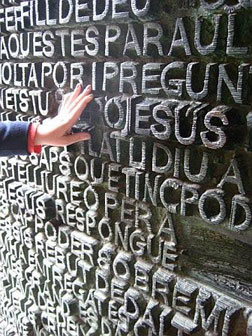
The entrance doors of the SAGRADA FAMILIA
(the hand is the author’s)
Photo by Kayetan Adamski
SAGRADA FAMILIA – the Gaudi Cathedral Gaudi’s stunning and massive cathedral has been under construction since 1882, and its construction is expected to continue into the first third of the twenty-first century.
Arrive an hour before opening time, especially if you’d like to take the lift to the top, so that you can be amongst the first in the entrance queue. Otherwise, expect to wait up to a couple of hours for entrance and the lift.
Before entering the Cathedral proper, examine the stunning entrance doors. Hewn from bronze, they describe the Cathedral’s two façades – the Nativity and the Passion.
Stroll around the interior and exterior with an audio guide, which details the Cathedral’s past, ongoing, and future work. Afterwards, visit the museum located directly beneath the Cathedral to explore a wonderful display of models, photographs, and drawings.
The museum’s highlight is a replica of the model Gaudi made as he was designing the cathedral. A series of strings and weighted sacks hangs above a large mirror – Gaudi took the shapes reflected below and incorporated them into his design.
A Note on Gaudi: CASA BATLLÓ, PALAU GÜELL, LA PEDRERA
Gaudi is synonymous with Barcelona: The Casa Batlló illustrates the legend of Catalan patron saint Sant Jordi, complete with dragon and its victims’ skulls. La Pedrera’s iconic roof features Gaudi’s famous medieval warriors. The Palau Güell, an earlier Gaudi work, boasts a wondrous façade and mosaic chimneys.
Most Gaudi dwellings allow visitors inside; they do, however, charge entrance fees. Delve into Gaudi at the SAGRADA FAMILIA instead if, like me, you’re fascinated by his work but not sure that a €15 entrance fee is worthwhile (especially for us converting American dollars to Euros). The exteriors can all be viewed – and enjoyed – for free.
MENJAR (FOOD)
Barcelonans love the art of food and its enjoyment; a mid-day meal may well last two, three hours; evening and late-night suppers can stretch through midnight. Bon Profit!

A plate of freshly-made gambas at the PINOTXO BAR
Photo by Kayetan Adamski
PINOTXO BAR – In LA BOQUERIA marketplace, La Rambla. Seafood. Go for lunch.
As you enter the marketplace from its main entrance on the Ramblas, turn right immediately. Walk down a few stalls and look for a food bar with a small wooden Pinocchio perched on its top corner. Be prepared to wait a bit for the limited seating. The bar is usually full of locals; follow their lead with regards to queuing up for the next available seats (sometimes there’s a line; sometimes folks just stand behind whoever they think will be leaving next).
Once you’ve snagged seats, ask the cooks behind the counter for their recommendations and specials. There are no menus; there are, however, small glass tanks of live seafood that you can examine and request for your meal.
Favorites: Garbanzo beans, made with brown sugar and cilantro – a bit sweet and incredibly fragrant; blancos (white beans) with baby squid; razor clams; gambas (shrimp). Supplement the meal with beer or small glasses of white wine; enjoy the clamor of the marketplace all around.
ESCRIBÀ CONFITERIA – La Rambla. Gourmet desserts.
Enter this Barcelona favorite through its exquisite Modernista storefront. The beautiful presentation and delicately-woven flavors are deliciously worth the prices (expect to pay 3-4 Euros for a pastry).
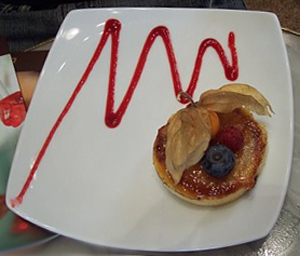
A sweet treat at ESCRIBA
Photo by Justine Jablonska
CAL PEP – Barri Gòtic. Tapas. Go for lunch.
Arrive early for lunch, or wait in line at the door. Once you’re in – eat at the counter. Ask the folks behind the bar for their recommendations.
We waved away the menus and asked our server (a tall, bald man with a knife scar on his cheek and tattoos on neck and forearms) to bring us whatever he thought was best that day. Stone-faced, he served us plate after plate of fresh, piping hot, exquisitely seasoned seafood – we first feasted on mussels in a delicate wine sauce, then buttery gambas and peppery clams. Sipping cold beers, we listened to local businesspeople discuss their workdays and the food. After giving our server a hearty “thank you” in Catalan for an amazing meal, we were treated to a quick but radiant smile.
ORIGIENS 99.9% – Barri Gòtic. Catalan cuisine. Go for lunch and/or dinner.
An extensive menu explains the origins of the various dishes and their significance in the region. Small but hearty portions allow you to sample and share the flavorful meat (pheasant, lamb, duck, chicken) and vegetable (beet, bean, eggplant) dishes. Enjoy these with a full-bodied Rioja and save room for dessert.
After your main course, order the xocolata desfeta – literally “melted chocolate.” This cross between hot chocolate and mousse is served piping hot with cookies for dunking. Another delicious dessert, if in season, features Muscat-soaked blood oranges with cinnamon.
RANJA-XOCOLATERIA – Barri Gòtic. Go for mid-morning or afternoon sweets.
Incredible chocolate and pastry shop. We visited three times (for research purposes, of course); each time, we were the only non-locals. Feast on their amazing cream puffs with light and moist dough and thick, slightly sweet whipped cream. The melted chocolate cup, xocolata desfeta, (accompanied by a hearty dose of thick whipped cream) is divine.
Note: My guidebook listed the address incorrectly; in case yours does too, the location is Petrixtol, 11.
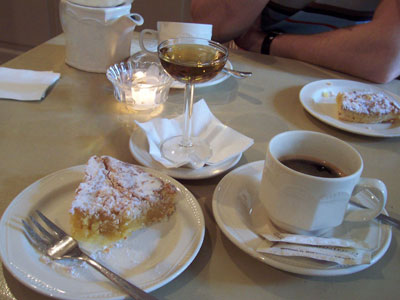
An afternoon treat at CAELUM
Photo by Justine Jablonska
CAELUM – Barri Gòtic. Go for mid-morning or afternoon sweets. This café and shop features products made by monasteries throughout Spain and Italy. Look for bars of xocolata negra amb oli i sal – dark chocolate with oil and salt. The salt brings out the rich flavor of the chocolate; heavenly! Fresh-baked pastries rest temptingly on a table in front of a large bay window. In either the ground-floor, airy café, or cozy, candlelit room below, try the Santa Maria Novella elixir with a lemon tart. The elixir (also sold in the shop) is reputed to cure any number of aches, pains, and woes. After enjoying a delicate goblet, I can definitely attest to feeling quite nice indeed.
EL SALTERIO – Barri Gòtic. Go for afternoon tea. This tiny tea bar on Sant Comenec del Call serves up hearty pots of made-to-order “Yogi” chai tea-hot milk and black tea, spiced with whole peppercorns, cardamom, cinnamon, and ginger. The intimate atmosphere is perfect for a relaxing and languid afternoon. We spent hours on a rainy afternoon sipping the fragrant tea and chatting, relaxing after a busy day of sight-seeing.
Gràcies (THANK YOU!)
…to Annie Simpson, who was kind enough to outfit me with a list of places to go and see and eat, and reminded me to peek over the walls of the Castell de Montjuïc to discover the stunning shipping port. Thanks to her, I also discovered two of what would become my favorite Barcelonian places: MUSEU FREDERIC MARÈS and PINOTXO BAR.
…to Kayetan Adamski, my wonderful host and companion around Barcelona. Together, we traipsed up and down countless streets, sampled many tasteful dishes, and explored and discovered the amazing details of Barcelona. Gràcies, kolego! CR
CR
